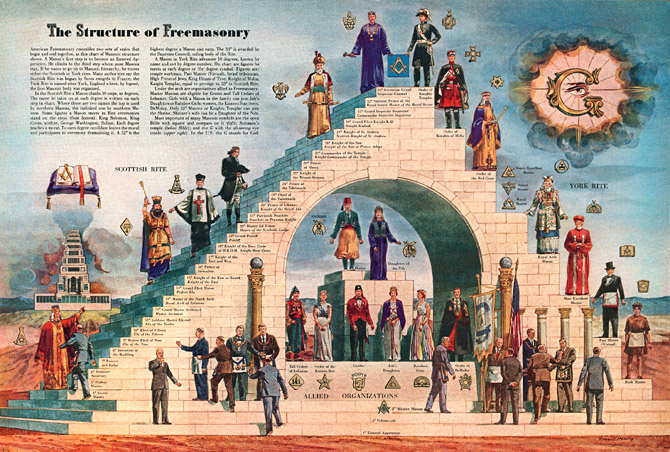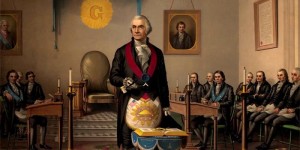At first glance, the overall structure of Freemasonry can be very confusing to the uninitiated. Besides the local ‘Blue’ or ‘Craft’ lodge, there are a number of other appendant and concordant bodies that may be associated with the local lodge in each town.
Charts like the following have no doubt incorrectly created the impression that the additional degrees of the Scottish and York Rite are somehow higher than the three degrees of Craft Freemasonry.
While no one is quite sure where the name ‘blue lodge’ originated, there are several explanations as to how this term originated:
– It could be because blue is generally regarded to be the color of truth and fidelity, and these are the basic teachings of the Craft.
– Blue also is the color used to characterize friendship, as in “a true blue friend“.
– The color blue has been used to trim and decorate Masonic aprons, collars and clothing down through the ages.
– It may be because Masonic allegory makes a reference to the “covering of the lodge being the star-decked canopy of the heavens“.
More properly, the local lodge is called a ‘Craft Lodge’ since the craft of Freemasonry is taught and learned there.
While many join Masonry to become a part of Scottish or York Rite, one has to become a Master Mason FIRST at the Blue/Craft Lodge level. In reality, there IS no higher degree than that of Master Mason…the additional levels in Scottish or York Rite simply build the Master Mason’s knowledge of Freemasonry.
A degree is a stage or level of membership. It is also the ceremony by which a man attains that level of membership. At the blue lodge level, there are three…Entered Apprentice, Fellowcraft, and Master Mason. The names are taken from the Middle Ages craft guilds. In the Middle Ages, when a person wanted to join a craft, such as the goldsmiths, the carpenters or the stonemasons, he was first apprenticed. As an apprentice, he learned the tools and skills of the trade. When he had proved his skills (“paid his dues”), he became a “Fellow of the Craft”, what we would call a “journeyman” today. Only when he had exceptional ability and was able to demonstrate those skills ands knowledge did he become known as a “Master” of his chosen Craft.
The degrees are plays in which the candidate participates. Each degree uses various symbols to teach, just as plays did in the Middle Ages and as many theatrical productions do today. The Masonic degrees teach the great lessons of life:
-The importance of honor and integrity;
-Of being a person on whom others can rely;
-Of being both trusting and trustworthy;
-Of realizing that you have a spiritual nature as well as a physical or animal nature;
-Of the importance of self-control;
-Of knowing how to love and be loved;
-Of knowing how to keep confidential what others tell you so they can “open up” without fear.
“Operative” vs. “Speculative”
Modern-day Masonry uses a lot of words, phrases and symbols which, although appearing a bit “foreign” or confusing, actually go back to the Middle Ages where Masonry first began.
A question that many people often ask is, “What is the difference between ‘operative’ and ‘speculative’ Masonry?” In truth, the terms should actually be “Operative Art” and “Speculative Science”.
 Operative masons in the middle ages formed groups with a hierarchy similar to what “modern” Masonry uses today. They had officers and stations which we still use today. Other men were admitted only after they had served a number of years of apprenticeship. This was the source of the first Masonic degree, the Entered Apprentice. Their focus as stonemasons was working with stone where masons actually did the physical labor of quarrying, forming, building and constructing.
Operative masons in the middle ages formed groups with a hierarchy similar to what “modern” Masonry uses today. They had officers and stations which we still use today. Other men were admitted only after they had served a number of years of apprenticeship. This was the source of the first Masonic degree, the Entered Apprentice. Their focus as stonemasons was working with stone where masons actually did the physical labor of quarrying, forming, building and constructing.
 Over time, civilization advanced and the art of masonry and those who practiced it started to be replaced by other building materials and architecture. Freemasonry survived by changing its focus; organized Freemasonry started allowing men into the Craft who, while not being actual physical builders of stone, were, instead, spiritual builders of good men. That Speculative Science is practiced by the Freemasons of the present day.
Over time, civilization advanced and the art of masonry and those who practiced it started to be replaced by other building materials and architecture. Freemasonry survived by changing its focus; organized Freemasonry started allowing men into the Craft who, while not being actual physical builders of stone, were, instead, spiritual builders of good men. That Speculative Science is practiced by the Freemasons of the present day.
Click here to view information on some of the other associated bodies of Freemasonry.
Click here to go to top of page
